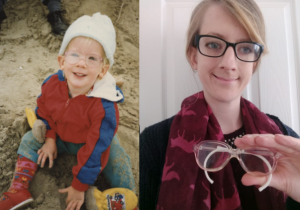The author of this blog, Dr Helen Clifford, is a Museums Consultant for the University of Warwick, and has held curatorial, research, and teaching posts across the UK. She kindly wrote us this piece to reflect on the memories triggered by looking at the childhood glasses of Jenny Crane, one of our researchers…
 prescribed had to be NHS, there was absolutely no other choice – and just one style. As I am much older than Jenny, (the test would have taken place in the early 1960s)- the only spectacles you could have were metal with springy ear pieces and the frames were covered in an opaque pink plastic (were they blue for boys? I don’t think so). I was quite pleased with these, until I went to school with them on. Suddenly I was marked out, there did not seem to be anyone else in my class wearing spectacles. The name-calling was merciless, ‘Specky Four Eyes’. It was the first time I was really upset at school. I came home in tears and my mother, ever resourceful, but misguided, decided that the problem with them was their ‘medical’ association. So she set to, and made tiny coloured felt flowers with leaves and stitched them on to the frames. They were lovely, but of course a disaster. This was really a turning point in my life. First I wore them to school, hoping no-one would see me, and then took them off as soon as I arrived, exacerbating my short -sight. I did not want to upset my mother, but I just knew what the reception in class would be. In the end I decided that actually it might be good to be different, and wore them stoically, amidst a barrage of laughter and taunts. But I stuck with them, and in the end I was accepted. It was a lesson well learnt, and the principle of this rite-of-passage has stood with me all my life.
prescribed had to be NHS, there was absolutely no other choice – and just one style. As I am much older than Jenny, (the test would have taken place in the early 1960s)- the only spectacles you could have were metal with springy ear pieces and the frames were covered in an opaque pink plastic (were they blue for boys? I don’t think so). I was quite pleased with these, until I went to school with them on. Suddenly I was marked out, there did not seem to be anyone else in my class wearing spectacles. The name-calling was merciless, ‘Specky Four Eyes’. It was the first time I was really upset at school. I came home in tears and my mother, ever resourceful, but misguided, decided that the problem with them was their ‘medical’ association. So she set to, and made tiny coloured felt flowers with leaves and stitched them on to the frames. They were lovely, but of course a disaster. This was really a turning point in my life. First I wore them to school, hoping no-one would see me, and then took them off as soon as I arrived, exacerbating my short -sight. I did not want to upset my mother, but I just knew what the reception in class would be. In the end I decided that actually it might be good to be different, and wore them stoically, amidst a barrage of laughter and taunts. But I stuck with them, and in the end I was accepted. It was a lesson well learnt, and the principle of this rite-of-passage has stood with me all my life. Should you wish to remove a comment you have made, please contact us



Hello again Helen! Great to hear your reflection on your wearer’s experience of NHS frames. I have revisited the spectacle design research I did on the V&A/RCA MA course ( my maiden name was Jo Lewis). I have been giving papers to fashion history conferences, have an article in the Science Museum Journal, and will be contributing to the conference this summer. I hope to get to talk to you more about how these frames contributed to identity…it is a story that really resonates with many people. Excited to take this topic further.
How super to get your message – and delighted you are researching this wonderful subject. Do get in touch, if you think I can help!